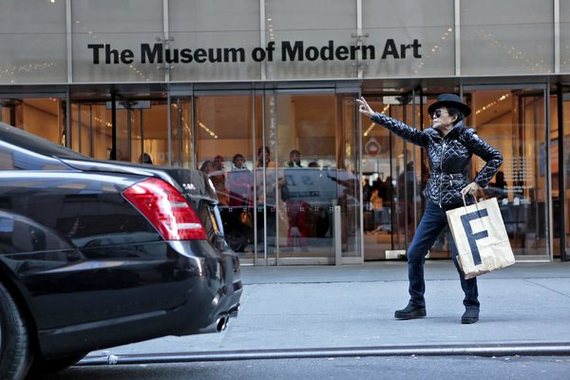 |
| Visitors appreciating the unique architecture of New York City's Guggenheim Museum. |
Much like the other disciplines we'll be looking at over the next few weeks, the visual arts is a remarkably broad and complex field that's not really all that easy to encapsulate briefly. At the same time, it's (sadly) a far more marginalized discourse than popular media like music and film and there's not quite the same pantheon of critics as we see in those fields — moreover, among the big names in art writing we find work that's both longer and more theoretically dense than what might be useful for our goals this semester (cf. Susan Sontag or Roland Barthes on photography). I've finally decided upon an approach that I'll also employ for some of our film readings: using parallel reviews of the same materials so that we might think analytically about the style and substance of each. For today, I've chosen a few landmark shows from the last decade.
 |
| Keith Haring poses with one of his graffiti pieces in the NYC subway system. |
- Karen Rosenberg, "A Pop Shop for a New Generation: 'Keith Haring: 1978-1982' at Brooklyn Museum," The New York Times [link] (related slideshow [link])
- Rachel Wolff, "Where the Radiant Baby Was Born," New York Magazine [link]
- Matt Morris, "You Don't Know Keith," CityBeat [link]
Next, we'll consider three pieces on the Brooklyn Museum's 2005 retrospective on Jean-Michel Basquiat, a friend and contemporary of Haring (and, I should add, a painter with a lot of literary influences who's also influenced a lot of writers):
- Roberta Smith, "Collisions on Canvas That Still Make Noise," The New York Times [link]
- Jerry Saltz, "To Hell and Back," The Village Voice [link]
- Mark Stevens, "American Graffiti," New York Magazine [link]
 |
| Kara Walker's A Subtlety, 2014. |
Since Jerry Saltz — a respected, if sometimes controversial figure in contemporary arts criticism (folks are just jealous they didn't get to be a judge on an art-themed reality TV competition on Bravo), who's written for The Village Voice and New York Magazine, among other venues — has come up, we can use him for a different sort of parallel investigation. We'll take a look at two pairs of pieces on the same artist (multimedia artist Kara Walker and photographer Cindy Sherman) each written four years apart:
- "An Explosion of Color, in Black and White" (on Kara Walker, 2007) [link]
- "Drawing from Nightmares" (on Kara Walker, 2011) [link]
 |
| Yoko Ono recreates her Museum of Modern (F)art cover outsude MoMA, 2015. |
We'll conclude with several pieces reflecting on one of this summer's most celebrated exhibitions, "Yoko Ono: One Woman Show, 1960–1971" at New York's Museum of Modern Art. Faced with a little more than 24 hours in the city this summer, I made it a top priority to see this show:
- Holland Cotter, "Review: In 'Yoko Ono: One Woman Show, 1960-1971,' Text Messages From the Edge," The New York Times [link]
- Ellen Pearlman, "Yoko Ono Finally Gets the Solo She Deserves," Hyperallergic [link]
- Edward M. Gómez, "MoMA's 'One Woman Show': Now, the Ballad of Yoko," Hyperallergic [link]
- Jason Farago, "Yoko Ono at MoMA Review — A Misunderstood Artist Finally Gets Her Due," The Guardian [link]

No comments:
Post a Comment